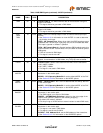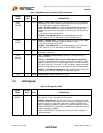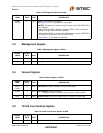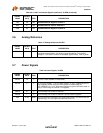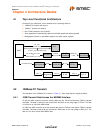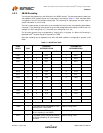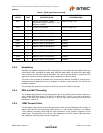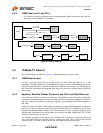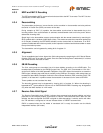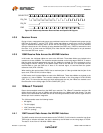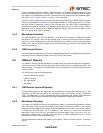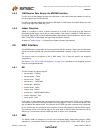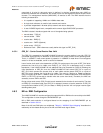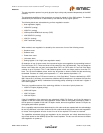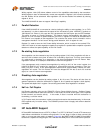
MII/RMII 10/100 Ethernet Transceiver with HP Auto-MDIX and flexPWR
®
Technology in a Small Footprint
Datasheet
SMSC LAN8710/LAN8710i 23 Revision 1.0 (04-15-09)
DATASHEET
4.3.3 NRZI and MLT-3 Decoding
The DSP generates the MLT-3 recovered levels that are fed to the MLT-3 converter. The MLT-3 is then
converted to an NRZI data stream.
4.3.4 Descrambling
The descrambler performs an inverse function to the scrambler in the transmitter and also performs
the Serial In Parallel Out (SIPO) conversion of the data.
During reception of IDLE (/I/) symbols. the descrambler synchronizes its descrambler key to the
incoming stream. Once synchronization is achieved, the descrambler locks on this key and is able to
descramble incoming data.
Special logic in the descrambler ensures synchronization with the remote transceiver by searching for
IDLE symbols within a window of 4000 bytes (40us). This window ensures that a maximum packet size
of 1514 bytes, allowed by the IEEE 802.3 standard, can be received with no interference. If no IDLE-
symbols are detected within this time-period, receive operation is aborted and the descrambler re-starts
the synchronization process.
The descrambler can be bypassed by setting bit 0 of register 31.
4.3.5 Alignment
The de-scrambled signal is then aligned into 5-bit code-groups by recognizing the /J/K/ Start-of-Stream
Delimiter (SSD) pair at the start of a packet. Once the code-word alignment is determined, it is stored
and utilized until the next start of frame.
4.3.6 5B/4B Decoding
The 5-bit code-groups are translated into 4-bit data nibbles according to the 4B/5B table. The
translated data is presented on the RXD[3:0] signal lines. The SSD, /J/K/, is translated to “0101 0101”
as the first 2 nibbles of the MAC preamble. Reception of the SSD causes the transceiver to assert the
RXDV signal, indicating that valid data is available on the RXD bus. Successive valid code-groups are
translated to data nibbles. Reception of either the End of Stream Delimiter (ESD) consisting of the /T/R/
symbols, or at least two /I/ symbols causes the transceiver to de-assert carrier sense and RXDV.
These symbols are not translated into data.
The decoding process may be bypassed by clearing bit 6 of register 31. When the decoding is
bypassed the 5
th
receive data bit is driven out on RXER/RXD4/PHYAD0. Decoding may be bypassed
only when the MAC interface is in MII mode.
4.3.7 Receive Data Valid Signal
The Receive Data Valid signal (RXDV) indicates that recovered and decoded nibbles are being
presented on the RXD[3:0] outputs synchronous to RXCLK. RXDV becomes active after the /J/K/
delimiter has been recognized and RXD is aligned to nibble boundaries. It remains active until either
the /T/R/ delimiter is recognized or link test indicates failure or SIGDET becomes false.
RXDV is asserted when the first nibble of translated /J/K/ is ready for transfer over the Media
Independent Interface (MII mode).



